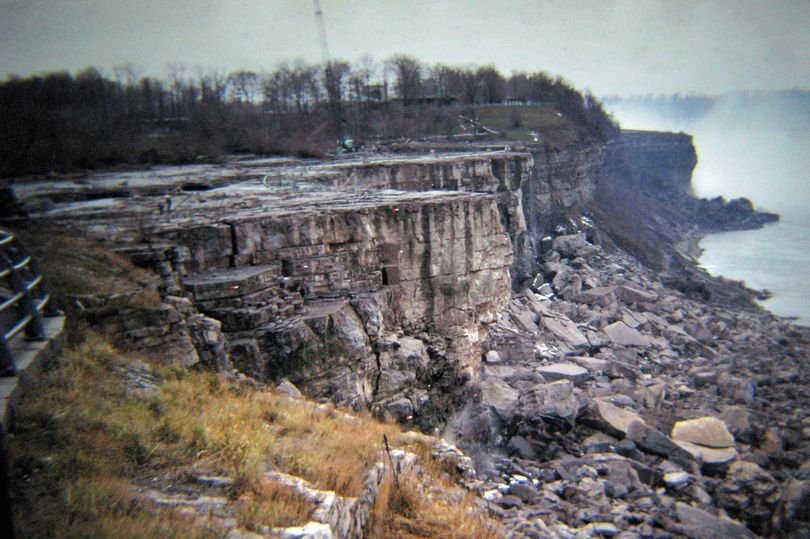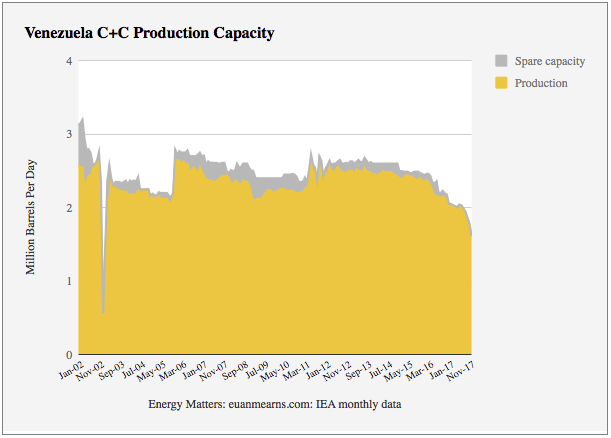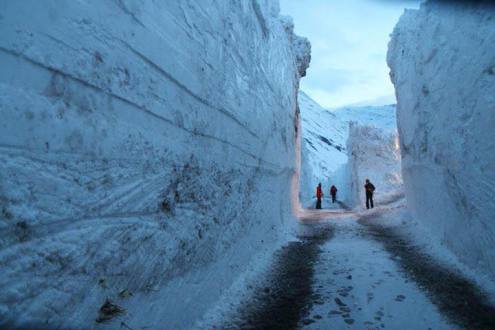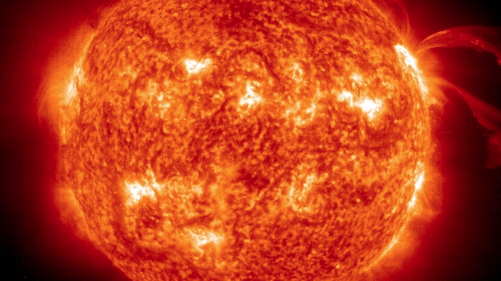Most of us do not think about the energy we use to get energy. This area of study that comes in different guises is commonly know as net energy analysis. This becomes important when energy production systems consume almost as much or even more than they ever produce. High latitude solar and temperate latitude biofuels being good examples where the net energy, i.e. the energy available to us, approaches zero (energy return over invested: ERoEI~1). Mandates, targets and laws are effectively squandering resources. In this post I take a look at the energy balance of uranium mining in Namibia. The ERoEI is dependent upon the reactor technology used. Light water reactors indicate the ERoEI for uranium mining to be >>300-400 and in a fast neutron reactor >17,380. These numbers compare with conventional oil ~ 20 and oil sands ~ 3.
The ERoEI of Mining Uranium
Dead Rose Country
Here’s an Alberta dairy farmer’s monthly gas bill.
Carbon tax = $311.65, plus GST.
For a tax the NDP hid from voters, and that they plan to raise by 67%, in this case to $520. https://t.co/nbLmIGvysK— Jason Kenney (@jkenney) February 21, 2018
Y2Kyoto: It’s Not Tampering
It’s Data Reassignment Therapy.
The National Oceanic and Atmospheric Administration (NOAA) has yet again been caught exaggerating ‘global warming’ by fiddling with the raw temperature data.
This time, that data concerns the recent record-breaking cold across the northeastern U.S. which NOAA is trying to erase from history.
If you believe NOAA’s charts, there was nothing particularly unusual about this winter’s cold weather which caused sharks to freeze in the ocean and iguanas to drop out of trees.
[…]
That’s because, as Paul Homewood has discovered, NOAA has been cooking the books. Yet again – presumably for reasons more to do with ideology than meteorology – NOAA has adjusted past temperatures to look colder than they were and recent temperatures to look warmer than they were.
We’re not talking fractions of a degree, here. The adjustments amount to a whopping 3.1 degrees F. This takes us well beyond the regions of error margins or innocent mistakes and deep into the realm of fiction and political propaganda.
Homewood’s original post is here.
Dead Rose Country
Got my first natural gas bill for 2018 today.
Cost of gas: $77.
Cost of carbon tax, er, “levy”: $52.
The total bill was $235.
So that’s like:
The carbon tax, er, “levy” amounted to a 67.5% tax on natural gas.
Or it’s like paying a 23% GST rate.
Thanks Rachel!
— D.B.Cooper (@GuardOfForever) February 17, 2018
Blowout 216
Britain’s free market approach to green energy is not going to save humanity from climate change, claims Labour’s Jeremy Corbin in this week’s feature story. So let’s nationalize the UK energy industry. Stories to follow include OPEC vs. shale; Venezuela’s collapse; Gazprom and Europe’s gas; nuclear in India, Taiwan, France and the Middle East; carbon capture & storage in the US and Norway; Bitcoin mining in Iceland; a Puerto Rico school goes solar; Elon Musk to shake up the Oz grid; CCGTs lose out to batteries and interconnectors in US and UK capacity auctions, blockchain grid balancing in Germany; Lord Deben questions Swansea Bay; the coming mini-ice age and the solution to climate change – more women.
Global Energy Forecast to 2100
A global energy demand forecast is presented to 2100 based on historic growth of per capita energy consumption, 1965-2015 and on UN low and medium population growth forecasts. The low forecast sees energy demand growing from 13.15 billion tonnes oil equivalent (toe) per annum in 2015 to 19.16 billion toe in 2100. The medium population forecast sees 29.5 billion toe in 2100, that is a rise of 124% over 2015.
Global Energy Forecast to 2100
PS Canada leads the world rankings in per capita energy use, using 9.8 toe per capita in 2008. This compares with Denmark at 3.1 toe.

Turning Canada into a Giant Battery
The potential energy contained in the waters of the Great Lakes amounts to approximately six thousand terawatt hours, enough to supply the US and Canada with electricity for an entire year were the lakes to be drained to sea level. This of course will never happen, but there may be potential for partial utilization of the resource. A pumped hydro system that uses Lakes Huron and Michigan as the upper reservoir and Lake Ontario as the lower could theoretically generate 10 terawatt-hours, or more, of seasonal energy storage without changing lake levels significantly. The most likely show-stopper is the increased likelihood of flooding in the lower St. Lawrence River during pumped hydro discharge cycles.
The pumped hydro storage potential of the Great Lakes

Niagara Falls run dry in 1969
Blowout 215
This week’s lead story highlights the perils of basing policy decisions on speculative computer models. It seems that the ozone layer isn’t healing as predicted after all, so the dangers of man-made CFC radiation are still with us. And if radiation doesn’t do the job other computer models now tell us that melting permafrost threatens us with death from mercury poisoning. And if neither happens the forthcoming magnetic pole reversal spells the demise of civilization as we know it. Lots more energy and climate-related stories in this bumper Blowout, too numerous to synthesize, but read on and enjoy anyway. They’re not all bad.
Y2Kyoto: End Of Snow
Let Them Burn Leftists
For the first time in many years, the federal government is stoking Western alienation as it proves unable to find its way in promoting resource development and access to export markets for Canadian energy, while trying to balance environmental considerations. The prime minister calls the dispute between Alberta and British Columbia — over B.C.’s attempt to ban shipments carrying Alberta’s oil from the Trans Mountain pipeline expansion claiming a fear of oil spills — a “disagreement between provinces.” That ignores the constitutional role the federal government has in interprovincial transportation and trade. Alberta’s Premier Rachel Notley is right: This is as much a fight between B.C. and the federal government as it is between Alberta and B.C.
In fairness, the federal Liberals have said they still support the Trans Mountain pipeline expansion and vow to see it built. It’s a promise that won’t help the Liberals garner many votes in Vancouver, but perhaps the Trudeau government is quietly hoping the pipeline’s owner, Kinder Morgan, gives up in frustration, for “business reasons,” as other resource project proponents have done recently after enduring endless regulatory and political setbacks.
[…]
The parts of Western Canada that rely on energy — Alberta, Saskatchewan and B.C.’s interior — are beginning to relive the consequences of Pierre Trudeau’s disastrous National Energy Program of 1980-85. The NEP, which hit the West just as commodity prices were falling, led to one of the largest income transfers in history, from the West to Central and Eastern Canada. Western energy producers were forced to pay an export tax to fund subsidies to make life cheaper for energy-guzzling consumers to the east. This time, the income isn’t being transferred from the West to Eastern Canada. It’s being transferred from Canada to the United States.
Related: Left vs Left vs Left
The Alarming Roots Of Environmentalism
Oil Production Vital Statistics
The oil price has begun 2018 strongly with Brent breaking through $70 / bbl for the first time since December 2014. OPEC+Russia+others’ discipline on production constraint remains high with ~ 1.7 Mbd production withheld from the market. The IEA reports an ~1 Mbpd stock draw in the OECD + China in 4Q 2017. IEA revisions transform the picture in the USA from one of static production to one of strong growth over the last 3 months (this undoes one of the assumptions used in my 2018 oil price forecast).
Oil Production Vital Statistics January 2018

Oil production in Venezuela has fallen 810,000 bpd since December 2014 and describes the slow motion train wreck taking place in that country.
Y2Kyoto: Chelsea Clinton Has A Fever
Blowout 214
An eclectic mix of energy and climate news stories from around the world:
This week’s feature story raises the intriguing question of whether Russia, already a de facto OPEC member, shouldn’t become a de jure one. We follow up with a series of unusually optimistic stories on the future of oil and gas; France’s load-following nuclear plants; China’s new nuclear mega-company; Fukushima as a tourist destination; the EU acts to keep coal and gas plants afloat; a climate skeptic in charge of EU environmental policy; cuts in US clean energy spending; Maine’s wind moratorium; the UK’s recent capacity market auction; Australia’s heatwave inflates power costs; Ex-Obama adviser rejects battery storage; a 500-year solar cycle and how climate change turns big beetles into little ones.
Challenging the Establishment
The last instalment (probably) of this mini-series, I go on a picture tour of the N hemisphere looking into big snow and extreme cold events and ask whether these events are down to CO2 warming or could they be linked to the premature death of sunspot cycle 24?
There’s huge snowfall in the Alps this year, and one picture in particular caught my attention.
The Death of Sunspot Cycle 24, Huge Snow and Record Cold

What has this winter been like where you are?
Challenging the Establishment
In my recent post on The Cosmogenic Isotope Record and the Role of The Sun in Shaping Earth’s Climate an interesting discussion developed in comments where there was a fair amount of disagreement among my sceptical colleagues. A few days later, retired Apollo astronaut Phil Chapman sent me this article which lays some of the doubts to rest. Phil never got to fly in space but was mission Scientist on Apollo 14. It is not every day I get the opportunity to publish an article from such a pre-eminent scientist.
Cosmic Rays, Magnetic Fields and Climate Change

The N magnetic pole used to lie in northern Canada, but not any more.
Y2Kyoto: The Planet Has A Fever
Recent Deaths In Texas Attributed To Climate Change
First, let’s pretend we’re back in USDA Hardiness Zone 7. We got pushed into the warmer Zone 8 in the newest map in 2012, but many of those Zone 8 plants have suffered mightily in our cold winters since. As you’re replacing them this spring, concentrate your re-plantings on Zones 7 and 6 plants that will hold up to the cold. Limit the numbers of more tender types that you plant to smaller quantities.
Related: The mercury fell to 2.6 degrees Celsius at Tetulia in Panchagarh on January 8, the lowest temperature ever recorded in the country’s history
Blowout 213
Donald Trump’s imposition of solar tariffs gets the nod as this week’s feature story. Does it signal a dismal future for solar in the US or is it just a bump in the road? In other news we have US shale spoiling the oil price rally; Austria on the nuclear warpath (again); Toshiba spins off Westinghouse; a nuclear reactor that won’t melt down; Canadians back renewables; Australia will meet its 2020 emissions target but Germany won’t; Macron’s tainted climate charm offensive; the “Tesla of the canals”; battery storage in the UK – yes or no? Budweiser beer is now 100% renewable and how bacon, egg and sausage sandwiches are to blame for global warming.
Y2Kyoto: End Of Snow
Juxtapose time!
The Guardian, Jan 20th

New York Times, Jan 22nd

Blowout 212
An eclectic mix of energy and climate news from around the world.
Without urgent action the UK will miss its climate targets, says this week’s feature story. What will it take to meet them? Carbon capture and storage and lots of electric cars. We follow with the US the world’s energy leader; Russian gas in Europe; NASA tests its mini-nuke; New York sues Shell & BP over climate change; the solar lobby files to stop construction of a Michigan gas plant; the EU ups its renewables targets; bitcoin miners flock to Canada; France to double wind capacity; Tesla’s Hornsdale battery gets paid for charging; UK wind and solar investment craters; Nike goes 100% renewable and how a warming Arctic is entombing musk oxen in ice and shrinking their babies.
